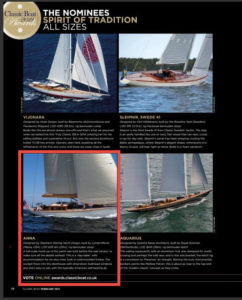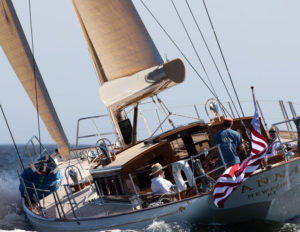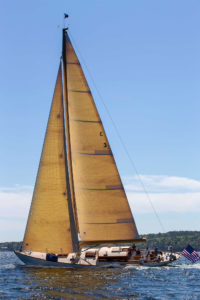
Anna nomination in the SoT Category for the Classic Boat Awards: Vote through March 10th here.
Hundreds of thousands of people have seen her online. Nearly 35,000 of them have reacted to her or said something or asked questions about her. Anna, our latest daysailer, has become quite the social media darling, during her first few weeks of competition in the Spirit of Tradition category in the 2019 Classic Boat Awards.
This annual award is organized by Classic Boat magazine, celebrating the best in classic and modern-classic vessels from around the globe. As part of the online voting, Anna is getting articulate, passionate and sometimes tough interrogation from a global community of sailors and classic-boat owners. The comments come in by the dozen in Spanish, French, Italian, Polish, Dutch and we believe Romanian, Russian, Bulgarian and Slovenian. Thank heavens for Google Translate.
Thank you one and all, from around the world, for considering this vessel seriously.
And since we have nothing to give back but our love of our craft, we figured why not answer some of your questions: Starting with the size, design and color of Anna’s boom and sailplan.
Anna’s Big New Boom.

Bigger, taller modern mainsails now roll into boom cavities, like this one on Anna.
On most modern sailboats, for over 25 years, owners and captains have been moving away from traditional hanked-on sails. It’s roller-furler everything when it comes to stowing the sails on today’s boats. Mainsails, jibs and even spinnakers now get wrapped around stays or stowed inside spars or even hidden inside booms. Anna is no different. Her large, modern, high-aspect mainsail rolls up like an upside-down window shade into a carbon-fiber boom cavity.
And it is this cavity that provides the structure for the sail and rigging. This cavity, just like booms of old, bears the load of the gooseneck, the vang, and mainsheet. To handle these demands, Anna’s boom cavity has to be big, heavy and wide enough to fit the mainsail that must be rolled inside it.
There are several interesting parts in the engineering of a modern boom cavity, and the rotating mandrel inside. On the mast end of the boom, near the gooseneck, there is a simple rotating fitting that holds the sail’s mandrel in the proper place in the boom. But on the aft end of the cavity, the bearing is driven by a motor, with enough power to roll the mainsail up as needed.
But to give the mainsail the room it needs to be hoisted or rolled, a slot is engineered through the top of the boom. This slotted cavity is not a convenient shape to make strong. Since even the most basic pipe will bend more easily if there is a opening cut along the top of it.
Getting all this engineering just right is so tricky that it is best left to experts who spend their days deep in the structural details of modern rigs, sails and booms. In Anna’s case, that’s the the smart folks at Southern Spars, part of North Sails. Southern Spars’ expertise has become so specific, that the firm has developed a standard line of boom cavities built of carbon fiber. That means, one cannot reasonably order a custom-diameter boom cavity unless dollars are unlimited.

Anna’s boom has to handle this entire sailplan.
Instead, you have to pick from a line of standardized booms. But, Anna is specifically designed to be a superior sailing boat. She features a seriously lofty rig with that high-aspect mainsail compared to vessels of similar design. To roll all that up, Anna’s boom had to be bumped from a size 4 mold, to a size 5 more often seen on a 90-foot boat.
We like the beefier look of the thicker boom. Serious racing boats from the mid-20th century, like Ranger and Intrepid, featured big booms that sent a message to the competition. To us, this boat says, “I may be lovely, but I am fierce.”
So fierce, that in the 2019 season, Anna’s boom will sport a lighter tone on its top one-third. That should better match the sail tone, and help blend the heft of the boom into the overall rig.
A Note on Anna’s Golden Sails.
We also got a fair number of questions on the brown, flaxen color of Anna’s sails. They are worth a deeper engineering explanation: Anna’s sails were fabbed from North Sails; 3Di technique, built like a boat’s composite hull. There are no sheets of material laid out to be sewn or glued. Instead, the sails are made directly from fibers and saturated with adhesives shaped over a cambered mold. There are no build ups of various layers of textiles or film — just a single lamination of non-woven fibers engineered to the proper shape to attach directly to the boat.
The brown color we chose was called 3Di Gold. It is a particular product aimed at the classic boat market. It is made of para-aramid fibers Kevlar and Twaron. The laminate is then covered in Dacron taffeta to aid in protection from the sun and reduce chafe.
To us, 3Di Gold is the best sailing technology out there for modern-classic boats. The material carries reasonable UV protection and is more durable than traditional Kevlar. It is a nice option for boats looking for a more traditional sail aesthetic.
To get a feel for the extra durability of 3Di, take the story of the sails on the 2017 round-the-world, Jules Verne Trophy race. The winner, called IDEC, lapped the globe in an insanely fast 40 days and 23 hours. Yet, it set this blistering pace using the same set of 3Di sails that had set a previous record back in 2016. And one sail, the J2 jib, was built in 2014 for yet another Jules Verne attempt. That same sail also survived a Route De Rhum race and a transatlantic delivery.
That’s the kind of durability that offers real value: One added benefit of 3Di: It is a thinner material than other options. Meaning there’s plenty of room inside Anna’s boom if another sail material becomes available.
Again, thanks for your support. The Classic Boat Awards stay open until March 10. Please vote here: https://awards.classicboat.co.uk/vote-now/